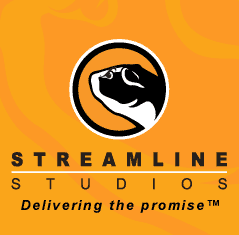 |
| |
MI6 caught up with Alexander L. Fernández,
and the team at Streamline
Studios, creators of the superb cinematic sequences
in NightFire for the PC...
|
|
Streamline Studios Interview (1)
26th December 2003
How were you approached to create the cinematics for
the game? How eager were you to be involved in a project that
was related to such a famous and world recognised series?
Landon Montgomery from Gearbox software emailed us out of the blue and
asked if we were interested in possibly creating the cinematics for the game.
The chance
of working on a high profile brand as James Bond is something you don’t
pass up. At that time our studio was relatively unknown and this project gave
us a chance to show the industry our abilities. Now that I got that out of the
way I’ll give you the straight dope, we screamed for a bit and then drank
beers. ;)
Were the storyboards or pre-visualization aspects already produced
by Electronic Arts? How much creative license you were given to create the
scenes?
The boards were created by EA and passed down to Gearbox who then in turn
passed them to us. Creative license was at first monitored by Dave Carson to
make sure
our team was up to par for the project. What’s interesting to note about
this is that Dave was giving us critiques on a frequent basis, which we enjoyed
as Dave worked in the film industry before arriving at EA. Anyone who can say
they did design work on "Empire Strikes Back" is someone worth listening to.
Towards the end of the project we were given free range to interpret
the storyboards and come up with our version of them.
What software do you use to create the scenes,
how much used is 'commercial' products that can be bought
off the shelf? What type of hardware is needed to render
and model such complicated scenes?
This is going to become a Discreet ad! All the software we used
is commercial. We used Max 4 along with Combustion for compositing
as well as a few
plugins such as Afterburn. To help facilitate the production process
we created some custom scripts to help with morph targets and other necessary
tools that aren’t pre-packaged with max.
Rendering of the Bond cinematics was completed on dual
2.0Ghz Athlon computers. They had about a gigabyte of
RAM each and handled the project like a champ. The only
complex
part was having to remote terminal into some of the farm
due to logistical issues that weren’t favorable
to the schedule. That’s another story in itself.
|
|

Above: Streamline Studios, based in Hilversum, Netherlands |
Do you think the originality and depth of the storyline
in NightFire is a way forward in making future games increasingly
like movies?
Definitely. NightFire had depth to it that is only going to increase with each
subsequent iteration of the video game series. There’s already a blending
of film and game methods as well as business practices that are only conducive
to the inevitable end result.
The core audience of gamers have grown up and demand more sophisticated
story lines and game play. This only forces the developers and
publishers to create compelling content that satisfies this demand.
What you’re going to see in the next few years is more
cinematic story telling that is more then just using the phrase
to sell units. They will actually be cinematic in feel and depth.
Of course this won’t push away the fact that it’s
still a video game. Instead, it will create a new experience
for the end user. We’re excited for it.
Is there anything you would have liked to have done with the cinematics
but couldn’t because of restrictions from MGM or EA? Did you find it
hard to satisfy their needs to create a convincing scene, which resembled
the Bond world from the movies?
MGM and EA had realistic expectations of what could be achieved.
Neil Haldar over at MGM was especially in tune with the overall production
process and his feedback of the project helped stimulate the overall production.
How challenging is staging a scene which involves character dialog compared
to an action or driving scene?
Dialogue can be tricky, especially when
you’re working
with rough temp tracks. Gearbox helped with the production of
the cinematics by having their developers read parts of the dialogue
that was to be synched with the cinematic. It was hilarious to
hear their performances, but without them we would have been
in production hell.
As for action sequences they can be more difficult especially
when you’re working from motion capture data that was taken
a year before the project started. There was a lot of hand animation
that went into the project in order to make up for the missing
movements, but over all the action sequences were far more time
consuming then they should have been.
Many thanks to Alexander and the team at Streamline
Studios
Stay tuned for Part 2 of the interview, where we look deeper
inside the production.
Related Articles
 MI6 "NightFire" Coverage
MI6 "NightFire" Coverage
 Interview
- Streamline Studios (Part 2)
Interview
- Streamline Studios (Part 2)